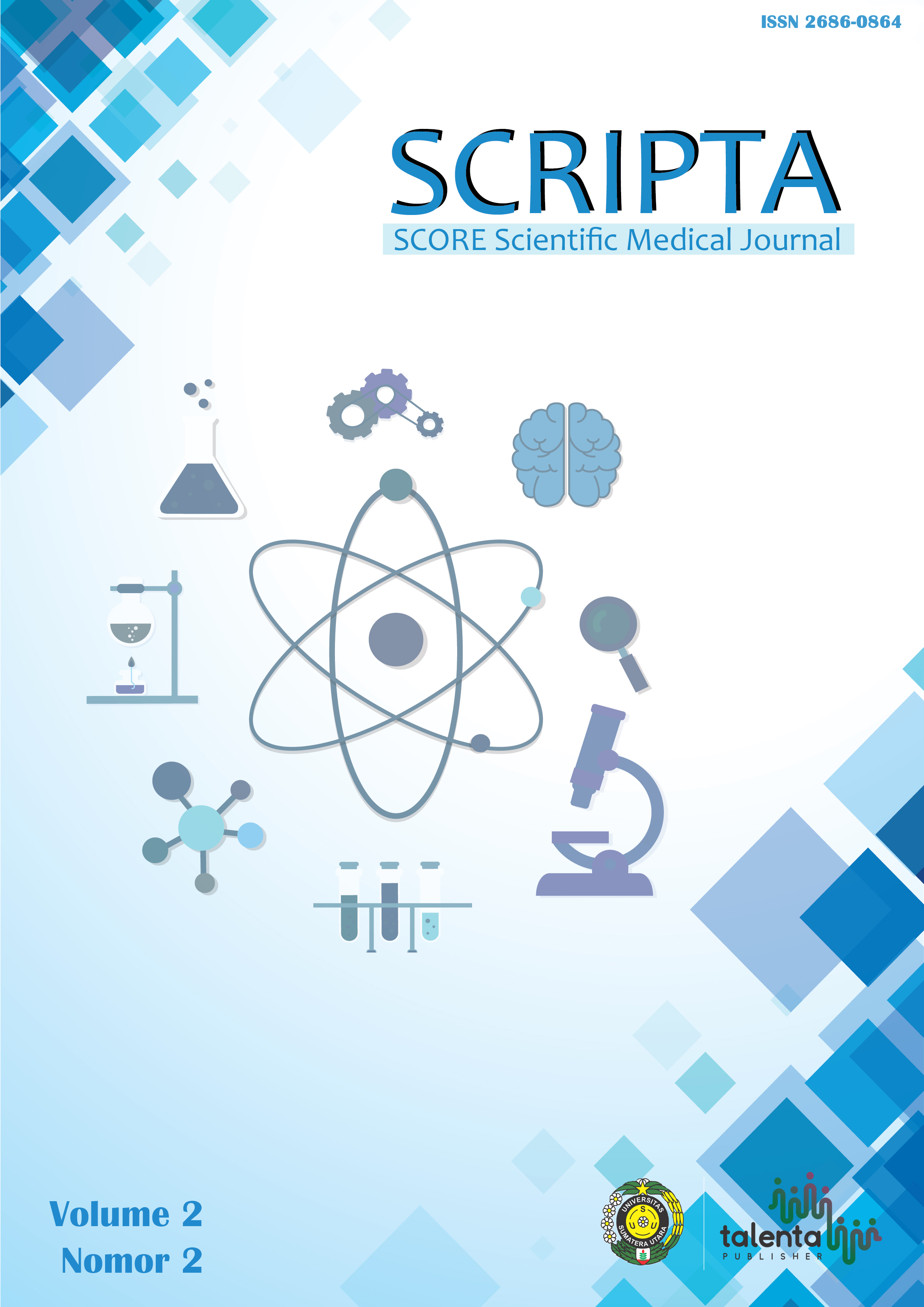Hubungan Kadar Hemoglobin Pada Ibu di Trimester III Kehamilan Dengan Kejadian Perdarahan Pascapersalinan di RSUP Haji Adam Malik Medan
DOI:
https://doi.org/10.32734/scripta.v2i2.3375Keywords:
hemoglobin levels, postpartum hemorrhage, vaginal delivery, kadar hemoglobin, perdarahan pascapersalinan, persalinan spontan pervaginamAbstract
Background: The maternal mortality rate in Indonesia in 2015 according to the Indonesian Demographic and Health Survey (IDHS) is still high at 305 per 100,000 live births. The highest cause of maternal mortality since the last decade is due to bleeding which is 30.3% and postpartum hemorrhage is the most frequent obstetric bleeding. One of the risk factors is anemia in pregnancy.
Objectives: This study aims to determine the relationship between hemoglobin levels in mothers in the third trimester of pregnancy with the incidence of postpartum hemorrhage in RSUD Haji Adam Malik Medan.
Methods: This study was an analytical research study with a case-control design, using secondary data derived from medical records at RSUP Haji Adam Malik Medan in 2017 – 2018. The study sample was determined using a purposive sampling method of all medical record data that met the study criteria and then analyzed using the chi-square test.
Results: From 36 mothers had postpartum hemorrhage (case group) was found that mothers who had experienced postpartum hemorrhage with anemia (Hb < 11 g/dl) in the third trimester of pregnancy as many as 30 people (83,3%) and which had normal Hb (Hb > 11 g/dl) in the third trimester of pregnancy as many as 6 people (16,7%). From the chi-square test had a significant result (p= 0.000; OR = 7.000).
Conclusion: There is an association between hemoglobin levels in mothers in the third trimester of pregnancy with the incidence of postpartum hemorrhage.
Keywords: hemoglobin levels, postpartum hemorrhage, vaginal delivery
Â
Latar Belakang: Angka Kematian Ibu di Indoensia pada tahun 2015 masih tinggi yaitu sebesar 305 per 100.000 kelahiran hidup. Penyebab kematian ibu tertinggi sejak satu dekade terakhir adalah karena perdarahan yaitu sebesar 30,3% dan perdarahan pascapersalinan adalah perdarahan obstetri yang paling sering terjadi. Salah satu faktor penyebabnya adalah anemia pada ibu hamil.
Tujuan: Penelitian ini bertujuan untuk mengetahui hubungan kadar hemoglobin pada ibu di trimester III kehamilan dengan kejadian perdarahan pascapersalinan.
Metode: Penelitian ini menggunakan desain penelitian case control, menggunakan data sekunder yaitu rekam medik di RSUP Haji Adam Malik Medan tahun 2017 – 2018. Sampel penelitian dipilih dengan metode purposive sampling dari seluruh data rekam medik ibu dengan persalinan spontan pervaginam yang memenuhi kriteria penelitian lalu dianalisis menggunakan uji chi-square.
Hasil: Dari 36 ibu dengan persalinan spontan pervaginam yang mengalami perdarahan pascapersalinan (data kasus) ditemukan bahwa ibu dengan persalinan spontan pervaginam yang mengalami perdarahan pascapersalinan dengan kadar Hb < 11 g/dl di trimester III kehamilannya sebanyak 30 orang (83,3%) dan yang dengan kadar Hb > 11 g/dl di trimester III kehamilannya sebanyak 6 orang (16,7%). Uji chi-square menunjukkan hasil yang signifikan (p = 0,000; = 7,000).
Kesimpulan: Terdapat hubungan antara kadar hemoglobin pada ibu di trimester III kehamilan dengan kejadian perdarahan pascapersalinan.
Kata Kunci: kadar hemoglobin, perdarahan pascapersalinan, persalinan spontan pervaginam
Downloads
Downloads
Published
How to Cite
Issue
Section
License
Copyright (c) 2021 Bella Fitriah Paramita, Khairani Sukatendel

This work is licensed under a Creative Commons Attribution-ShareAlike 4.0 International License.
Authors who publish with SCRIPTA SCORE Scientific Medical Journal agree to the following terms:
- Authors retain copyright and grant SCRIPTA SCORE Scientific Medical Journal right of first publication with the work simultaneously licensed under a Creative Commons Attribution-NonCommercial License that allows others to remix, adapt, build upon the work non-commercially with an acknowledgment of the work’s authorship and initial publication in SCRIPTA SCORE Scientific Medical Journal.
- Authors are permitted to copy and redistribute the journal's published version of the work non-commercially (e.g., post it to an institutional repository or publish it in a book), with an acknowledgment of its initial publication in SCRIPTA SCORE Scientific Medical Journal.














